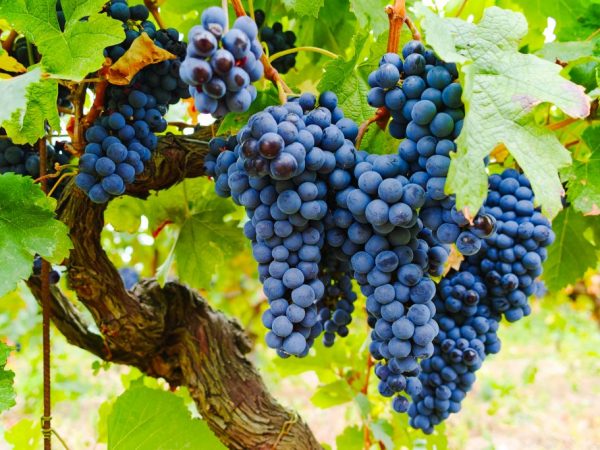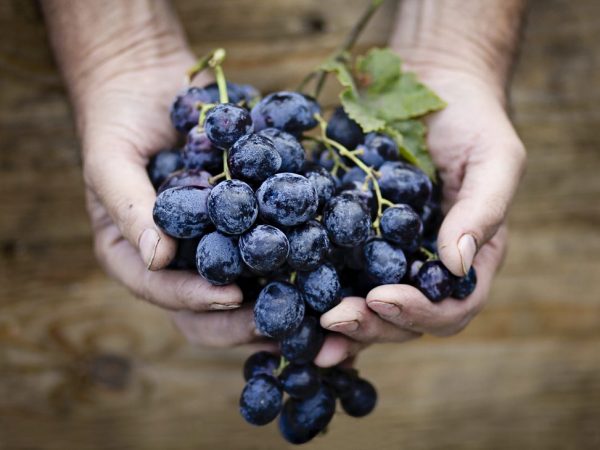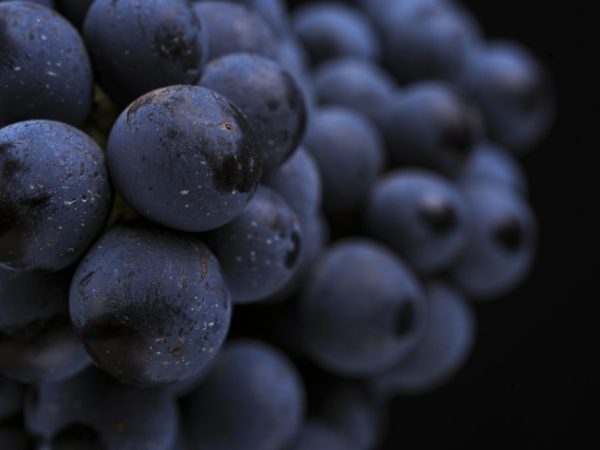Isabella black grape
The Isabella grape is a technical hybrid with dark berries. It belongs to the oldest varieties, it was bred 2 centuries ago. Even in the last century, it was grown on an industrial scale. Now grapes have given way to higher quality varieties. The vine is found in private farms, it is planted as an ornamental plant.

Isabella black grape
Origin
Isabella wine grape is one of the oldest hybrids. It was obtained by crossing the American Vitis Labrusca and the European Vitis Vinifera. After the opening of the New World, seedlings of the new Labrusca grapes began to be imported to Europe. Together with them, diseases such as phylloxera and powdery mildew (white powdery mildew) got to the Old World. At the end of the 18th century, whole vineyards with unique varieties perished in many countries due to pests and fungi.
European winemakers had no choice but to try to cross the American and local vines. The hybrid was first bred in 1816. Then his pink version of Lydia was created. The new varieties proved to be resistant to phylloxera and oidium, as well as to a number of other fungal diseases. They turned out to be extremely hardy.
Distinctive features
Hybrid grapes have a number of characteristics that distinguish them from traditional European varieties:
- Immunity against fungal diseases and phylloxera, which greatly facilitates cultivation and maintenance.
- Frost resistance, the vine grows well even in the northern regions.
- High content of anthocyanins and pectin in fruits and skins.
- High calorie content.
- During the fermentation of the variety, more methyl alcohol, harmful to the body, is formed than other varieties.
Today the Isabella grapes are losing ground. Gradually, new varieties appear, surpassing it in quality and yield. At the end of the last century, an increased content of methanol was found in wine made from black berries, because the alcoholic drink was banned in Europe and the United States, industrial vineyards were almost completely destroyed, and the cultivation of the variety was discontinued.
Outside the European Union and North America, the variety continues to be cultivated. It is grown in Ukraine, southern Russia, Azerbaijan, Georgia, Japan, China. But in these countries, too, the number of industrial vineyards is declining as demand falls. New vines are planted in private households.
Description of the variety
Isabella grapes are classified as black hybrid varieties. He has vigorous bushes with medium maturity of the vines. The leaves are three-lobed, with an open petiole notch, which resembles an arch in shape. The size of the leaves is medium to large. Above they are dark green, below - gray-green due to the abundant edge. The flowers are bisexual.
Ripening terms are late, their duration is from 130 to 170 days.In temperate zones, the harvest is harvested in mid-October; in warm regions, the harvest period begins at the end of September.
Description and main properties of the fruit:
- The bunch is dense, sometimes of medium friability, cylindrical, looks sloppy.
- The weight of ripe bunches is 0.5-1.5 kg.
- The berry has a round or slightly oval shape.
- The sizes are average.
- The color is black or dark blue.
- The intense bloom on the skin gives the berry a blue hue.
- The fruit ripens evenly, does not crack.
- The acidity level is 6-8 g / l.
- The sugar content is 16-20%.
- The taste is nutmeg.
- Caloric content - 70-73%.
The Isabella variety has a special aroma that distinguishes it from other varieties. Some people claim that it looks like ripe strawberries, others like wet fox hair. Among a number of winegrowers, its name "fox" has even been established. The smell is especially pronounced during the period of fruit ripening.
The yield of the variety is average, 60-70 kg are harvested per hectare. On one fruitful vine 3-4 clusters are formed. In some cases, 8 bunches appear on the branch, but in such a situation they need to be thinned out. Thickening leads to depletion of the vine, crushing of the berries. The next year, the yield drops sharply, the vine grows poorly and ripens.
Useful properties of grapes

Grapes have a positive effect on the body
The dark large fruits contain almost all vitamins and microelements necessary for a person. This grape is especially rich in potassium and iron. Potassium affects the myocardium and improves heart function, iron increases the level of hemoglobin in the blood, so Isabella is recommended to eat for anemia. Vitamin PP, which is found in large quantities in fruits, prevents allergies.
Anthocyanins are a valuable component of berries. These substances give the fruit a dark color. They have a positive effect on the immune system, they are able to stop the growth of cancerous tumors. Pectins, the number of which in the hybrid is increased, also strengthen the immune system and improve digestion. Flavonoids, catechins and polyphenols increase the overall tone of the body, eliminate toxins, protect the liver and improve its function.
Isabella grapes thins the blood, lowers cholesterol levels, which prevents the formation of atherosclerotic plaques on the vessels. Its benefits for heart disease are not only that. The berry reduces blood pressure and strengthens the myocardium. The rich composition has a positive effect on the condition of the skin and the work of all organs. It is recommended to eat it to prevent aging, improve performance. To increase the effectiveness of the grape diet, it is recommended to eat berries with seeds and skins.
It turns out that not only the fruit of Isabella grapes has benefits. The leaves of this plant also have medicinal properties and are used in folk medicine. They contain natural antiseptics, so the leaves are applied to wounds to avoid infection. Steamed leaves are used to gargle with sore throat. If you attach a few green leaves to the patient's body, they will reduce the fever and relieve pain.
Harm from Isabella grapes
Isabella grapes are good for the body, but under certain circumstances they can cause harm. Doctors do not recommend eating black fruits for the following conditions:
- A high content increases gas formation in the intestines, therefore grapes are not recommended for people prone to flatulence. Even a healthy person should not overuse berries.
- An increased amount of simple carbohydrates makes berries dangerous for diseases such as diabetes.
- The content of calories in fruits is increased, the energy value of the product is 70-73 kcal / 100 g, which is higher than that of other varieties. This variety is not advised for obese people who want to reduce the calorie content of the menu.
- Polyphenols negatively affect kidney filtration. The hybrid is contraindicated for people with chronic and acute diseases of these organs.
- After eating the fruit, it is worth rinsing your mouth, because.juice damages tooth enamel.
- In some cases, the hybrid causes allergies.
- You can not combine the use of grapes with milk, fatty foods, carbonated water, so as not to cause digestive problems.
- Pregnant, lactating women and children under 3 years old, the Isabella grape variety will not be useful.
In order for grapes to be useful, all contraindications to its use should be taken into account. You should also not overuse berries, otherwise the benefits from them will turn into harm.
Dangerous properties of grapes
Back in the 70s of the last century, it was revealed that Isabella wine contains more methyl alcohol than other brands. Studies in different countries of the world have confirmed this feature. It is associated with the fact that pectins are converted into methyl alcohol during fermentation. They are found in any variety of grapes, but Isabella has more of them in its composition. If in wines from European varieties the amount of this substance is 30-40 mg / l, then in Isabella it is 70-120 mg. It finds its way into both industrial and homemade wines.

Eating a lot of berries can be harmful
Methyl alcohol is decomposed in the digestive tract into formaldehyde and formic acid. Formaldehyde has a negative effect on the liver and nervous system. It damages the optic nerve and causes blindness. In high doses, the substance is life-threatening, in low doses it causes chronic poisoning.
Over the past decades, many firms have tried to refute this claim. There is information that in some brands of red wines, methyl alcohol is even higher, up to 350 mg / l. They called the data a falsification, ordered by the producers of more expensive types of wine, because the Isabella brand belongs to the cheap price category.
But most winemakers, as well as national governments, have a different opinion. Now this mark is banned in Europe and most of the vineyards have been destroyed, almost not a single planting has survived. Growing at home continues, but more often as an ornamental plant.
Isabella grape care
Breeding a hybrid is not difficult. Most growers prefer to cultivate the vine from seedlings. They take root well and take root quickly.
It is better to prepare the material in the fall, store it in the basement or on the lower shelf of the refrigerator. Any of the known methods is suitable for rooting the workpiece. Cuttings are planted in April or May; autumn planting is also possible. Choose a place that is sheltered from the wind and well lit. Preferably on the south side of a house wall or fence.
The vine of this variety is winter-hardy, therefore it is grown without shelter, even in the conditions of the Moscow region. Branches can freeze only in the northern regions: in Siberia, in the Urals. In these regions, they are advised to cover them in the fall after the pruning is completed.
Caring for Isabella grapes requires careful moisture control. The variety does not tolerate drought, it is preferable to grow it in humid regions. It suits the mountainous, seaside, Moscow region climate. The first watering is carried out in the spring, when the temperature of the air and soil rises to 10 ° C-15 ° C. Then the bushes are watered every 2-3 weeks. If summers are dry and hot, a little more often, as needed.
It is necessary to feed the bushes 3-4 times per season. Mineral and organic fertilizers are used. Organic matter is applied no more than once every 2-3 years, in summer or early spring. At the beginning of the season, fertilizing with nitrogen is applied, at the end - potash and phosphorus fertilizers. The variety is resistant to most diseases, because the vine does not require special preventive treatment. One has only to monitor the condition of branches, leaves and fruits in order to identify a fungal infection in time.
Autumn pruning is carried out using the standard method. It begins when the harvesting period is over and the leaves fall from the bushes, but before the start of frost. After the pruning is finished, the cuttings are thrown away or left for the winter to plant new bushes in the spring.This ends the seasonal care. According to the description, the vine is sheltered in autumn only in regions with a cold climate.
Using
The large-fruited Isabella grape variety is considered technical. Most of the products are recycled. But many people like the original taste and aroma of berries, because in the fall, large black bunches are often sold in the market and even in supermarkets. With the advent of new varieties, the hybrid has significantly lost its position, although it still has fans.
Alcoholic drinks
For almost two centuries, the main area of application of the variety has been winemaking. Industrial and homemade wine was obtained from it. The quality of the drink is average, it has a scent reminiscent of wet fox hair and a flavor that not everyone likes. Wine of this brand is not stored for long. After 2-3 years, it begins to deteriorate, acquires a putrid taste. This is the reason why the drink has always been considered cheap.
To date, an alcoholic drink is practically not produced anywhere on an industrial scale. Even in countries where isable wine is not officially banned, winemakers prefer to switch to other brands. But homemade is still popular. In Georgia, other alcoholic beverages are made from this hybrid. For example, after distilling fermented grapes, chacha is obtained.
If you mix the berries with sugar, then add alcohol or vodka to them, you get a delicious tincture. It is ready to use in 3 weeks.
Cooking
A popular area of application of the Isabella variety is the production of juices and compotes. Juices are still produced on an industrial scale, because methyl alcohol is formed only during fermentation. The combinations of grapes with apples or pears are tasty, but strawberries and raspberries only spoil the taste. The ripening period is different, because there are few opportunities to mix them during harvesting.
Black berry looks beautiful on cakes, desserts, cocktails, because it is used to decorate various dishes. Due to its characteristics, it combines well with meat both in taste and in appearance.
Jams and jams are made from the fruits. For the winter, products are frozen, then added to fresh compotes, baked goods. Freezing is advised to pulp, individual berries and whole clusters. Drying the fruits is not recommended, because they have large bones.
Summarizing
The Isabella variety still finds fans. This black grape is unpretentious, disease resistant, and grows even in regions with cool climates. He is planted in courtyards, gazebos, balconies are decorated with it, arches are made. It is simple to take care of the plant at home, it is easy to cut, water and fertilize it, there is no need to treat it against diseases.


